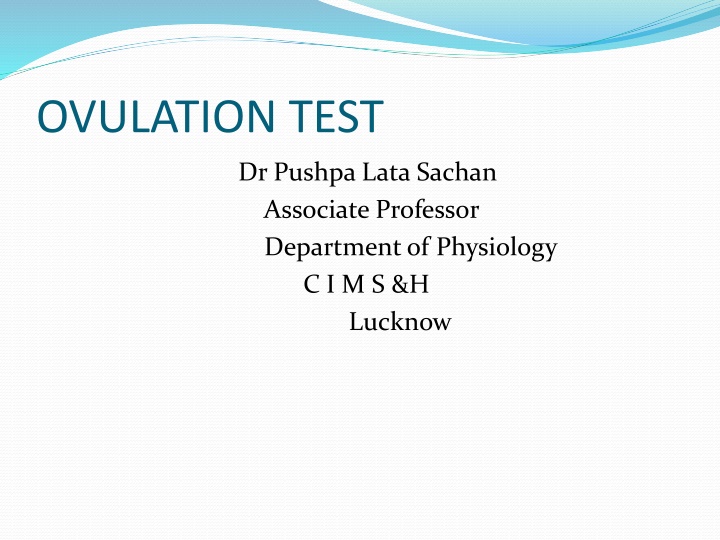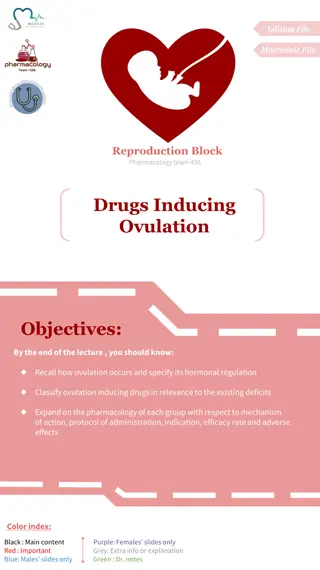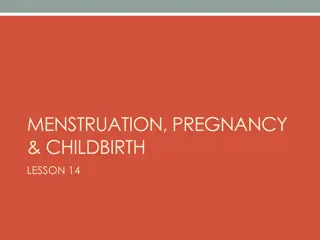
Ovulation: Signs and Indicators Explained
Explore the indicators of ovulation such as rise in basal body temperature, abdominal pain, vaginal discharge, and cervical mucus changes. Learn how to identify the day of ovulation for its physiological significance. Dive into the process explained by Dr. Pushpa Lata Sachan, Associate Professor at C.I.M.S. & H. Lucknow.
Download Presentation

Please find below an Image/Link to download the presentation.
The content on the website is provided AS IS for your information and personal use only. It may not be sold, licensed, or shared on other websites without obtaining consent from the author. If you encounter any issues during the download, it is possible that the publisher has removed the file from their server.
You are allowed to download the files provided on this website for personal or commercial use, subject to the condition that they are used lawfully. All files are the property of their respective owners.
The content on the website is provided AS IS for your information and personal use only. It may not be sold, licensed, or shared on other websites without obtaining consent from the author.
E N D
Presentation Transcript
OVULATION TEST Dr Pushpa Lata Sachan Associate Professor Department of Physiology C I M S &H Lucknow
Ovulation -Is the process of ovum from ovary that result from rupture of graffian follicle at the end of follicularphase of the menstrual cycle. It is important to know the day of ovulation for its physiological and clinical significance. Indicators of ovulationare as follows.
Indicators of ovulation 1- Rise in of basal body temperature Increases during ovulation by about 0. 5c . Accurate charting of this temperature can exactly detect the day of ovulation . (a) It is recorded orally ,early in the morning before getting up of bed ,and before taking any drink or washing the mouth.
(b) The increase in body temperature is due to the influence of progesterone that starts increasing with the beginning of secretory phase . Progesterone is thermogenic . (2) Fleeting lower abdominal pain -With ovulation ,bleeding occur into antrumof follicle .
(a) Small amount of blood escapes into abdominal cavity which causes peritonial irritation and abdominal pain. This is called as (Mittelschmerz) . (3) Vaginal discharge (Spotting ) Transitory increase in vaginal discharge during ovulation . (a) When rise in BBT is associated with mittelschmerz and spotting collectively called as ovulation cascade .
(b) If all the three features are present occurrence of ovulation almost confirmed . 4 Spinnbarkeit in proliferative phase ,estrogen makes the cervical mucous thin and alkaline. (a) With the beginning of secretory phase ,progesterone secreted from corpus luteum makes the mucous thick and tenacious . (b) Thus ,uterine mucous is thinnest at the time of ovulation and its elasticity is maximal .
(b) Spinnbarkeit - Cervical mucus at the time of ovulation can be stretched as long as 10 cm or more like a thread. This elastic nature of mucous is called as spinnbarkeit . (c) Decreased elasticity indicate ovulation has taken place .
Fern test 5 Fern test under the effect of estrogen ,cervical mucus before ovulation forms an arborizing fern like pattern, when the mucus is spread on slide. (a) This is confirmed by microscopic examination of the mucous smear. (b) Following ovulation , due to progesterone effect , the mucous become thick and fern pattern is not observed in smear of mucous.
6- Laparoscopic observation Demonstrating ovum in abdominal cavity by laparoscopy confirm ovulation . 7 Demonstration of LH Peak LH surge occurs just prior to ovulation . Daily estimation of plasma LH in the periovulatory period will accurately detect the day of ovulation .






















